TECH WEEKLY: The impact of two landmark F1 cars from Niki Lauda’s career
Mark Hughes and illustrator Giorgio Piola join forces once again to look back on two landmark cars from the legendary Niki Lauda’s career – the Ferrari 312T and the McLaren MP4/2B.


As F1 celebrates its 75th anniversary this coming Monza weekend, and off the back of the Dutch Grand Prix, it’s a good time to look at two landmark F1 car designs, both associated with the legendary Niki Lauda.
The Ferrari 312T of 1975 was the car which took then-26-year-old Lauda to the first of his three world titles. The 1985 McLaren MP4/2B was the car in which 36-year-old Lauda won his final Grand Prix – at Zandvoort – before retiring for good at the end of the season. These two cars, respectively 25 and 35 years into the F1 World Championship’s history, show just how fast F1 technology evolved in the intervening decade.
Designed by the genius Mauro Forghieri, the Ferrari was at the cutting edge of 1975 F1. Conforming to the 3-litre F1 in force at the time, it was a beautifully integrated design. Neither turbocharging nor ground effects had yet hit F1, the introduction of both technologies to the category not coming until two years later. The Ferrari 312T was the ultimate iteration of the pre-ground effect, normally-aspirated F1 car.
At its heart lay the flat-12 engine designed by Forghieri and used by the team since 1970. Laying the cylinders down flat (in two banks of six) rather than in the conventional vee positions of rival engines lowered the car’s centre of gravity and allowed a greater volume of air to flow to the underside of the rear wing, boosting downforce.
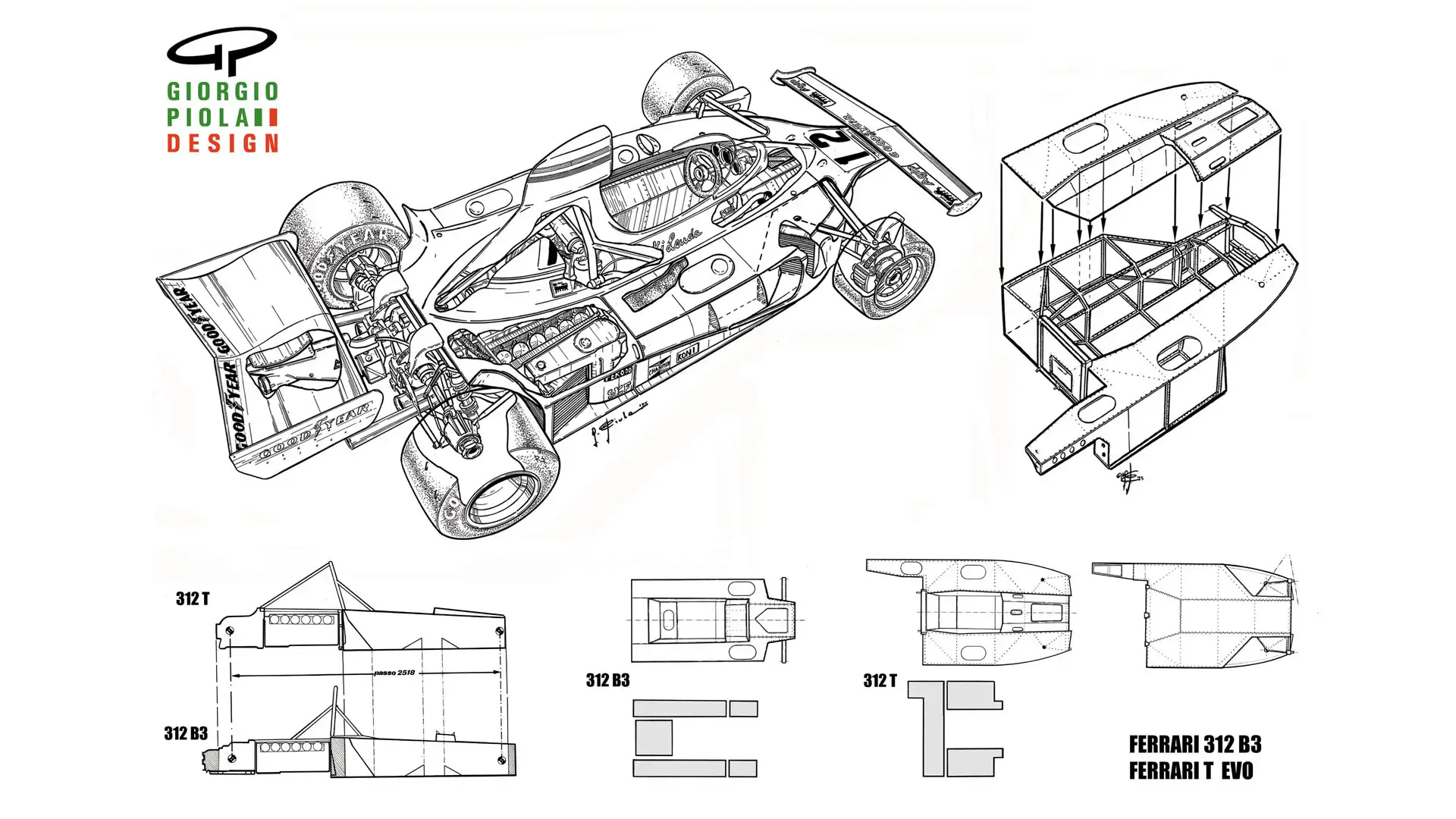
It had taken some time for Ferrari to fully exploit these two inherent advantages, however. Although the 312B and 312B2 models had won races regularly between 1970-72, the dominant teams of the time were Lotus and Tyrrell, both of which used the Ford Cosworth DFV engine, a brilliant design available to customers off the shelf. Its V8 format made it more compact (and slightly lighter) than the flat-12, and it used less fuel.
Forghieri came to realise that the Ferraris – in having to incorporate the 12-cylinder engine and bigger fuel tanks – were a little longer than ideal, denying them the agility of the best Cosworth cars. Forghieri began to think about how to centralise the car’s mass to give it that same agility despite the long engine.
Taking a break from running the F1 team in 1973, he designed an experimental prototype with a very short wheelbase – enabled by moving the radiators from the front and rear to the sides and re-siting the fuel and oil tanks. The distinctive nose of this design earned it the nickname of ‘The Snowplough’. Although it was never raced, the late-season version of the 1973 312B3 race chassis incorporated its side radiator layout.
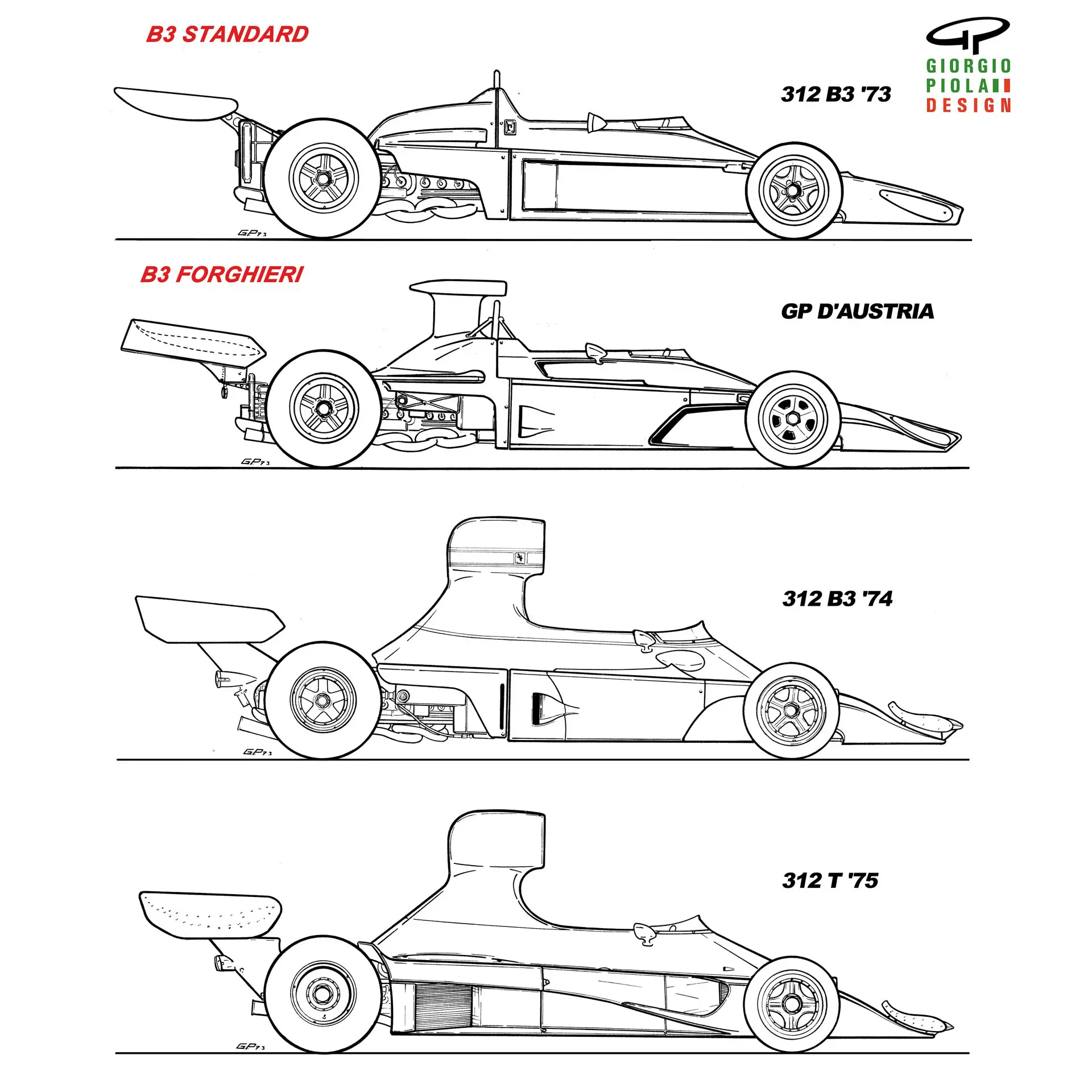
This became the basis of the 1974 car. It was still labelled the 312B3 but was very different in appearance to the previous year’s machine. It incorporated the side radiator layout but Forghieri had further optimised the layout of the side bodywork to make a bigger gap beneath the rear wing.
The area freed up at the front from moving the radiators was used to fashion a big delta front wing, taking its inspiration from the ‘snowplough’ prototype. It also featured much wider bodywork, as Forghieri had realised from running his 312P design in the enclosed wheel sports car World Championship that the bodywork width could be used to help create more downforce.
The skinny ‘toothpaste tube’ F1 cars of the previous era in the late 1960s/early '70s had prioritised lowering drag. There was a growing realisation that there was more lap time in using the bodywork to enhance downforce than would be lost to the greater drag. The 1974 312B3 pitched that trade off where Forghieri reckoned would give the best compromise.
It was a big success – comfortably the outright fastest car of the season, with Lauda scorching to nine pole positions in his first season with the team. But although team mate Clay Regazzoni took the title fight to the final round, ultimately Ferrari lost out to McLaren’s Emerson Fittipaldi.

But Forghieri knew there was more performance to be unlocked, if he could centralise the car’s mass even further. The more centralised the mass, the greater agility a car will have. His solution was to turn the gearbox sideways. This transverse layout was acknowledged in the 312T designation.
It made its debut in the fourth round of the ’75 championship and went on to power Lauda to five victories and a comfortable win in the Drivers’ World Championship. Ferrari won the Constructors’ for the first time in 11 years – and would go on to win the following two as well.
Ferrari’s mid-1970s pre-eminence was brought to an end by the advent of ground effect aerodynamics – introduced in 1977 by the Lotus 78. The airflow through the sidepod venturi tunnels which generated the negative pressure from the underfloor was effectively blocked by the Ferrari’s flat-12 layout.
Rather than adapt the flat-12 into a V12 – as Alfa-Romeo did during that time – Ferrari instead concentrated on creating a new turbocharged 1.5-litre V6 engine, which would race for the first time in 1981.
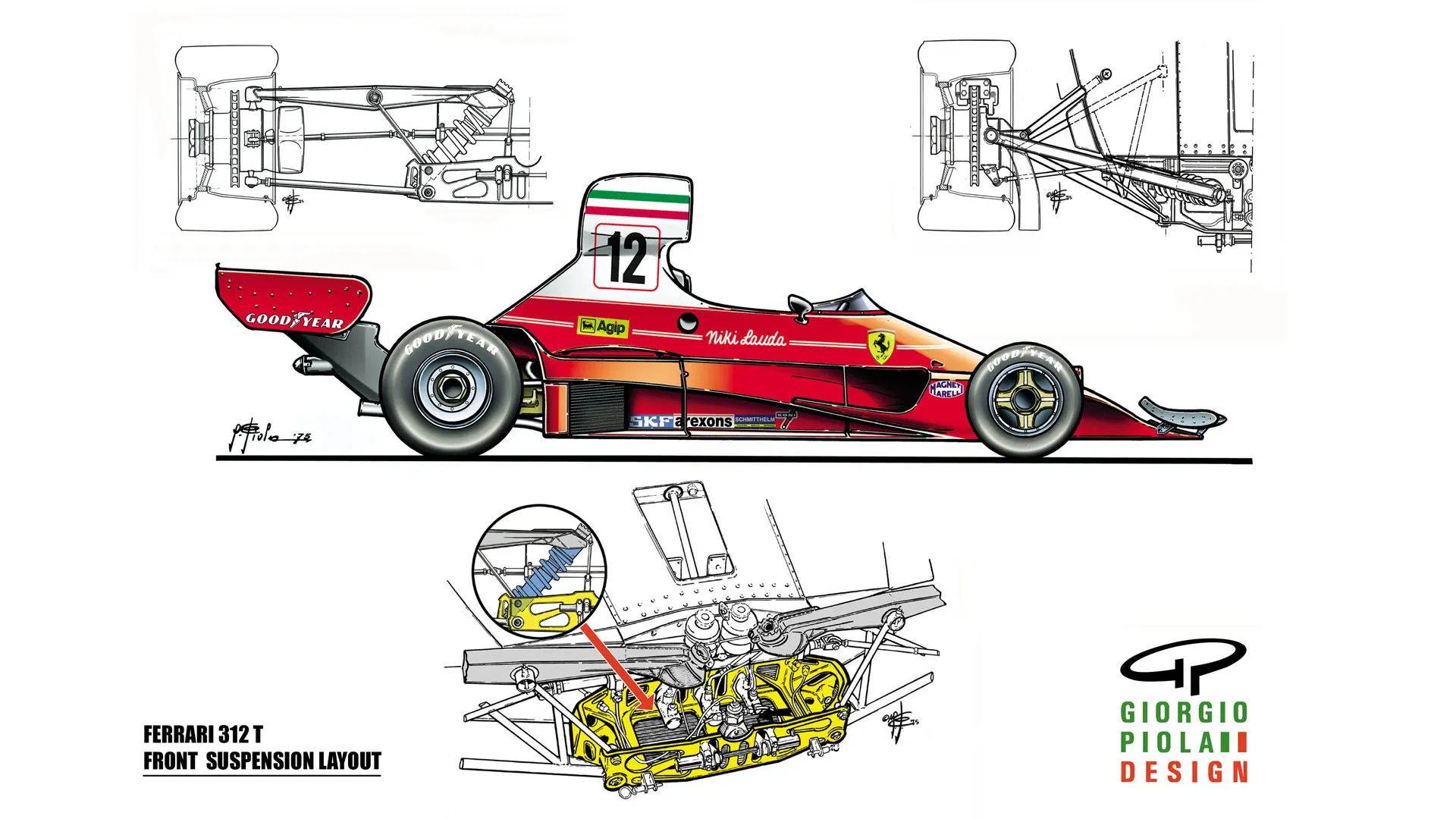
Turbocharging had been introduced to F1 by Renault in 1977. The 3-litre formula regulations in place since 1966 had always allowed for a forced induction engine, but at half the permitted capacity of a naturally-aspirated motor. This penalty was felt to be too restrictive to make a supercharged or turbocharged engine competitive. But Renault thought otherwise – and eventually were proved dramatically correct.
By 1985 the various turbos from Renault, BMW, Ferrari etc were delivering up to 1,500bhp in Qualifying trim, with around 750bhp available in the races. This compared to around 515bhp of the final version of the Ferrari 3-litre flat-12 in 1980. Ground effect aerodynamics had brought similar giant gains in downforce until the governing body stepped in to regulate flat-bottom cars from 1983.
All these developments had intrigued Lauda in his two-year hiatus from F1 in 1980-81. That technical fascination was part of what attracted him to the idea of returning to F1 – for McLaren in 1982.
McLaren had pioneered the use of carbon fibre as the material with which to construct the chassis. It allowed a vastly stiffer chassis for a lower weight than a conventional aluminium chassis – and by a happy coincidence, much better impact protection.
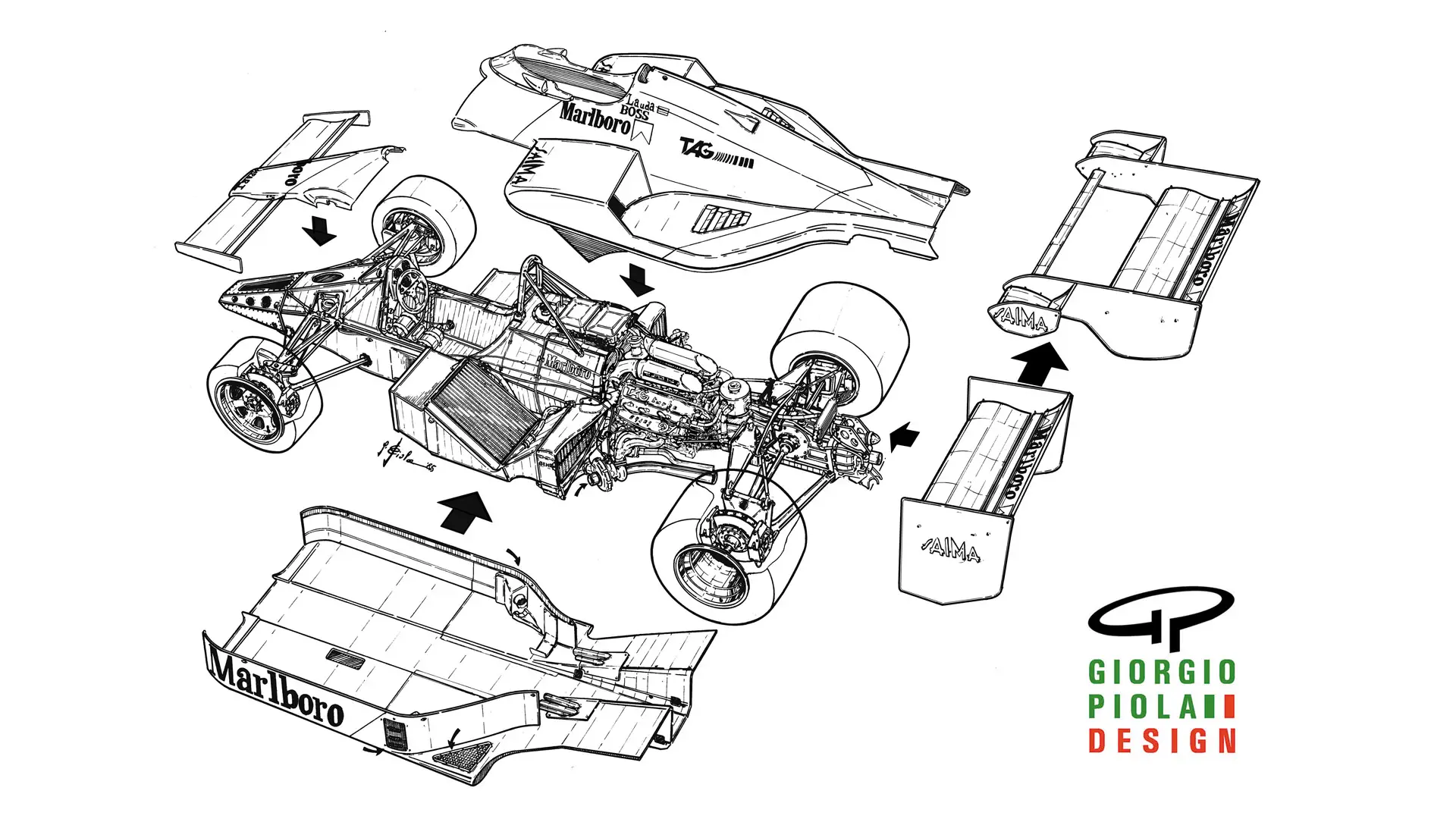
The search for performance had actually contributed to greater safety. This too appealed to Lauda as he prepared to make his F1 return, something which would culminate in his winning a third world title in 1984, in the McLaren-TAG MP4/2. It was designed by John Barnard, who specified the dimensions and layout of the V6 turbo engine to Porsche, the contracted supplier. The motor was labelled a ‘TAG’ in recognition of the funding of it by McLaren’s partner, Mansour Ojjeh’s Techniques Avante Garde company.
For 1985, the MP4/2 was lightly modified to make the MP4/2B. Lauda qualified it at Zandvoort only 10th-fastest but that was not so unusual. The strength of the car was in the race, where the great fuel efficiency of its engine (there was a regulation maximum fuel capacity of 220 litres) allowed Lauda and team mate Alain Prost to use more boost than the thirstier Renault, Ferrari and BMW engines. A decade’s worth of technical progress meant that Lauda’s qualifying time was over 7s faster than his pole time of 1975 in the 312T.
That car had steel brakes and aluminium chassis. This one had carbon fibre brakes and chassis – not to mention around 50% more power and more efficient aerodynamics.
The race boiled down to a no-holds-barred dice between Lauda and Prost. The latter was on his way to his first World Championship but Lauda used all his guile to keep the younger driver behind him to the flag. It was his 25th and final Grand Prix victory.
Next Up
Related Articles
 Beyond The GridToto Wolff and Hywel Thomas on Mercedes’ 2026 prospects
Beyond The GridToto Wolff and Hywel Thomas on Mercedes’ 2026 prospects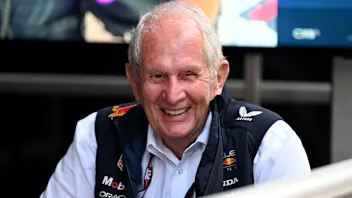 TremayneWhy ‘true racer’ Marko will be missed as he leaves Red Bull
TremayneWhy ‘true racer’ Marko will be missed as he leaves Red Bull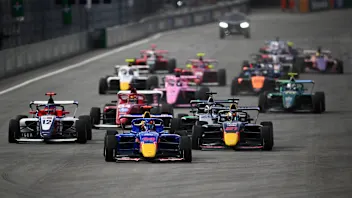 F1 ACADEMY unveils calendar for 2026 season
F1 ACADEMY unveils calendar for 2026 season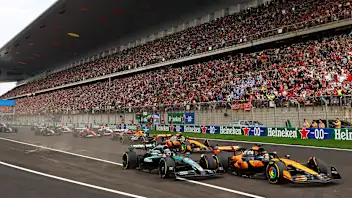 Tickets on sale for 2026 Chinese Grand Prix
Tickets on sale for 2026 Chinese Grand Prix Piastri 'will be a world champion' in future – Norris
Piastri 'will be a world champion' in future – Norris Tsunoda's best moments in F1 as he departs the grid
Tsunoda's best moments in F1 as he departs the grid